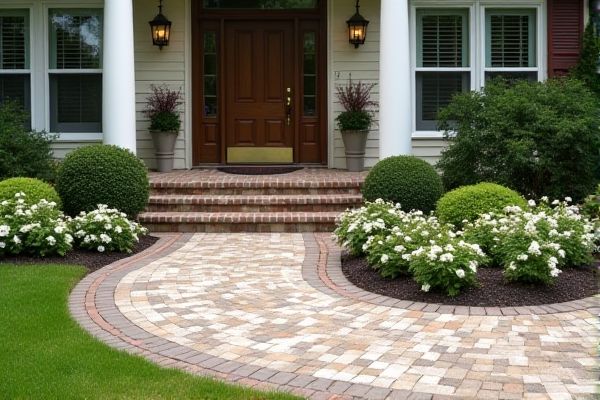
Paver borders create a seamless, decorative frame that enhances the visual appeal of your paved areas, while edging stones provide a more rigid, structural boundary that contains soil and prevents turf encroachment. Discover which option best suits your landscaping needs by reading the rest of the article.
Table of Comparison
| Feature | Paver Border | Edging Stones |
|---|---|---|
| Material | Concrete, brick, or natural stone pavers | Natural stone, concrete, or metal |
| Installation | Laid flat and joined to create a continuous border | Placed vertically or angled to define edge |
| Durability | High, resists shifting under pressure | Moderate to high, dependent on material and installation |
| Functionality | Defines hardscape areas and prevents paver movement | Separates lawn/bed from paths, controls soil erosion |
| Appearance | Uniform, solid border look | Varied shapes and natural aesthetics |
| Cost | Moderate to high depending on material | Generally lower but varies by stone type |
| Maintenance | Low, minimal upkeep needed | Low to moderate, weeds can grow between stones |
| Best Use | Driveways, patios, pathways with pavers | Garden beds, lawns, natural landscapes |
Introduction to Paver Borders and Edging Stones
Paver borders and edging stones serve as essential elements in landscaping, enhancing both functionality and aesthetics. Paver borders typically consist of uniform, interlocking bricks or stones that create a defined frame for patios, pathways, or driveways. Edging stones vary in shape and size, designed to separate garden beds from lawns or walkways, preventing soil erosion and providing a clean, polished look.
Key Differences Between Paver Borders and Edging Stones
Paver borders are typically larger, decorative units used to create defined perimeters that enhance landscape aesthetics, while edging stones are smaller, functional pieces designed primarily to separate garden beds from lawns or pathways. Paver borders often come in uniform shapes and sizes, allowing for consistent, patterned layouts, whereas edging stones vary in form and can be installed more flexibly to follow curves and irregular garden shapes. The durability of paver borders generally supports heavy foot traffic and structural uses, contrasting with edging stones that mainly serve as containment barriers for soil and mulch.
Material Options for Borders and Edges
Paver borders are commonly made from concrete, brick, or natural stone, offering durability and design flexibility for patios and walkways. Edging stones often include granite, limestone, or recycled materials, providing a sturdy containment for garden beds and landscapes. Choosing the right material for your paver border or edging stones ensures longevity and complements your outdoor aesthetic.
Aesthetic Impact on Landscape Design
Paver borders create clean, defined lines that enhance the geometric precision of a landscape, often providing a sleek and modern aesthetic. Edging stones add a natural, rustic charm by blending seamlessly with garden beds and pathways, offering a softer transition between lawn and hardscape. Choosing between the two depends on the desired visual effect: sharp sophistication with paver borders or organic integration with edging stones.
Installation Process Comparison
Paver border installation involves laying interlocking stones in a continuous pattern to create a defined edge that enhances durability and stability, often requiring a compacted base and precise alignment. Edging stones installation typically uses individual pieces set in a trench with mortar or gravel to secure them, offering more flexibility in shapes but potentially less cohesion compared to paver borders. Both methods require proper base preparation and leveling, but paver borders generally demand more meticulous fitting for a uniform look, while edging stones allow easier adjustments during installation.
Durability and Maintenance Factors
Paver borders typically offer superior durability due to their thicker construction and ability to withstand heavy loads and weathering, making them less prone to cracking or shifting compared to edging stones. Maintenance for paver borders is minimal, often requiring only occasional cleaning and joint replenishment, whereas edging stones may need frequent realignment and can suffer damage from lawn equipment or soil erosion. Choosing paver borders enhances long-term stability and reduces upkeep costs, especially in high-traffic outdoor areas.
Cost Analysis: Paver Borders vs Edging Stones
Paver borders typically cost more upfront due to the higher price of materials and the labor-intensive installation process compared to edging stones, which are generally more affordable and easier to install. The durability and aesthetic appeal of paver borders often justify the increased investment, providing long-term value by reducing maintenance costs. Your choice depends on balancing initial budget constraints with the desired landscape design and longevity.
Suitable Applications and Use Cases
Paver borders are ideal for defining garden paths, patios, and driveways by creating a clean, continuous frame that enhances structural integrity and aesthetic appeal. Edging stones work well for controlling soil erosion, separating flower beds from lawns, and managing landscape areas with irregular shapes or slopes. Your choice depends on whether you need a durable boundary for hardscape projects or flexible delineation for softer landscape features.
Pros and Cons of Each Option
Paver borders offer a uniform, sturdy edge that prevents shifting and provides a clean, cohesive look, making them ideal for heavy foot traffic areas, but they may require professional installation and higher upfront costs. Edging stones provide flexibility in design, easier installation, and cost-effectiveness, allowing for creative shapes and easy repairs, but they might shift over time without proper anchoring and may not hold heavy loads as effectively. Choosing between paver borders and edging stones depends on factors such as budget, durability requirements, and aesthetic preferences.
How to Choose the Right Option for Your Project
Choosing between paver borders and edging stones depends on your project's aesthetic goals, durability requirements, and budget. Paver borders offer a cohesive look by matching the driveway or patio surface, providing both visual appeal and structural support. Edging stones create a distinct separation between lawns and paved areas, ideal for controlling grass growth and enhancing garden beds with versatile shapes and sizes.
 homyna.com
homyna.com